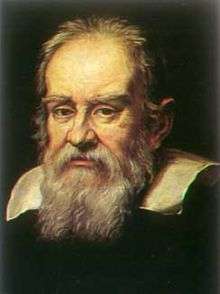Maria Celeste
| Maria Celeste | |
|---|---|
 Painting believed to be an image of Maria Celeste | |
| Born |
16 August 1600 Padua |
| Died |
2 April 1634 (aged 33) Florence |
| Nationality | Italian |
| Other names | Virginia Galilei |
| Occupation | Roman Catholic Nun |
| Relatives |
Galileo Galilei (father) |
Sister Maria Celeste (16 August 1600 – 2 April 1634), born Virginia Galilei, was the daughter of the Italian scientist Galileo Galilei and Marina Gamba.[1]
Biography
Virginia was the eldest of three siblings, with a sister Livia and a brother Vincenzio.[2] All three were born out of wedlock, and the two daughters were considered unworthy for marriage. Troubled by monetary problems, Galileo placed them in the San Matteo convent shortly after Virginia's thirteenth birthday.[3] When she took the veil in 1616 Virginia chose her religious name, Maria Celeste, in honor of the Virgin Mary, and her father's love of astronomy.
From her cloister Maria Celeste was a source of support not only for her Poor Clares sisters, but also for her father. Maria Celeste served as San Matteo's apothecary (herself being of frail health). She sent her father herbal treatments for his various maladies while additionally seeing to the convent's finances and sometimes staging plays inside the convent's walls. There is evidence she prepared the manuscripts for some of Galileo's books.
Maria Celeste frequently asked her father for help, and kept the convent afloat through his influence. Galileo helped repair windows and made sure the convent clock was in order.[4][5] Maria Celeste was a mediator between her father and her brother.[6]
The Inquisition tried Galileo for being vehemently suspected of heresy in 1633. He was forced to recant his views on heliocentrism, and he was sentenced to house arrest for the remainder of his life. Soon after Galileo returned to Arcetri in disgrace, Maria Celeste contracted dysentery; she died on 2 April 1634, aged 33.
Galileo described Maria Celeste as "a woman of exquisite mind, singular goodness, and most tenderly attached to me".[7]
Work
After Galileo's death, 124 letters from Maria Celeste written between 1623 and 1633 were discovered among his papers. Galileo's responses to Maria Celeste—possibly describing what kind of help she brought to his work and describing his state of mind during the Roman trial—seem to have been lost. Maria Celeste's letters have been published:
- (Italian) Virginia Galilei, Lettere al padre on Wikisource[8]
- (English) Galilei, Maria Celeste, and Sobel, Dava. Letters to father: suor Maria Celeste to Galileo, 1623-1633. New York: Walker & Co., 2001 Also online
Legacy
- Maria Celeste appears as a character in the play Life of Galileo, by Bertold Brecht and Margarete Steffin. The play does not give an accurate portrayal of her life as it depicts her becoming engaged, rather than as a nun.
- The International Astronomical Union has named the impact crater Maria Celeste on the planet Venus after her.[9]
Notes and references
- (Italian) Favaro, Antonio. Galileo Galilei e suor Maria Celeste, p. PP7, at Google Books, Florence: G. Barbèra, 1891
- Sobel, Dava. Galileo's Daughter: A Historical Memoir of Science, Faith and Love, Penguin Group, 1999, 420 p. ISBN 9780670878048. Numerous formats and translations. Official website
- Galileo Project
- ↑ Maria Celeste sometimes signed letters to her father « Maria Celeste Galilei ». Favaro, p. 235, p. PP235, at Google Books
- ↑ In the Italian editions of her letters "Vincenzio" is found much more often than "Vincenzo".
- ↑ The special permission Galileo needed due to their young age he got thanks to his protector cardinal Francesco Maria del Monte.
- ↑ From 1631 until his death in 1642 Galileo lived nearby (less than a hundred meters away) in the Villa Il Gioiello
- ↑ Maria Celeste (Virginia) Galilei (1600-1634), site of the Galileo Project
- ↑ Vincenzio asked for money.
Galileo's financial charges included his brother, Michelagnolo, his sister's rich dowry, his two daughters in a poor convent, and his son. A detailed explanation of the situation is given by Mark Covington and Amit Mistry: The Status of Women in Galileo’s Time on the site of the Galileo Project. - ↑ Galileo, quoted by Favaro, p. 203, p. PP203, at Google Books
- ↑ Wikisource's text is from the Bibliotheca Augustana, itself based on Morandini, Giuliana , Suor Maria Celeste Galilei, Lettere al padre, Torino: La Rosa, 1983. There exists an older edition of the Lettere, which is the second part of Favaro's book (from page 235), p. 235, at Google Books
- ↑ Cattermole, Peter and Moore, Patrick. Atlas of Venus, p. 126, p. 126, at Google Books. Cambridge University Press, 1997 ISBN 0521496527, ISBN 9780521496520
